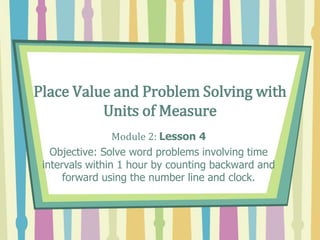
Math module lesson 4
- 1. Place Value and Problem Solving with Units of Measure Module 2: Lesson 4 Objective: Solve word problems involving time intervals within 1 hour by counting backward and forward using the number line and clock.
- 2. Group Counting (3 minutes) Direct students to count forward and backward using the following suggested sequences, occasionally changing the direction of the count: Sevens to 49, emphasizing the 35 to 42 transition Eights to 56, emphasizing the 40 to 48 transition Nines to 63, emphasizing the 45 to 54 transition
- 3. Fluency Practice Tell Time on the Clock (3 minutes) Show an Analog Demonstration: We will start at 12 count by 5 minutes on the clock. I’ll show a time on the clock. Write the time on your board. Repeat process, varying the hour and minute so that students read and write a variety of times to the nearest minute.
- 4. Fluency Practice Minute Counting (6 minutes) Direct students to count by 5 minutes to 1 hour, and then to the half hour and quarter hours. 6 minutes, counting to 1 hour, and naming half hour and 1 hour intervals as such 3 minutes, counting to 30 minutes, and naming the quarter hour and half hour intervals as such 9 minutes, counting to quarter ’til 1 hour 10 minutes, using the following sequence: 10 minutes, 20 minutes, 1 half hour, 40 minutes, 50 minutes, 1 hour
- 5. Application Problem. (5 minutes) Patrick and Lilly start their chores at 5:00 PM. The clock and the number line show the times that Patrick and Lilly finish their chores. Who finishes first? Explain how you know. Solve the problem without drawing a number line. You might want to visualize or use your clock template, draw a tape diagram, use words, number sentences, etc.
- 7. Concept Development (33 minutes) Problem 1: Count forward and backward using a number line to solve word problems involving time intervals within 1 hour. Look back at your work on today’s Application problem. We know that Lilly finished after Patrick. Let’s use the number line to figure out how many more minutes than Patrick Lilly took to finish. Slip the Number Line Template into your personal white boards. Label the first tick mark 0 and the last tick mark 60. Label the hours and 5 minute intervals. Plot the times 5:31 pm and 5:43 pm. We could count by 1’s from 5:31 to 5:43, but that would take a long time. Discuss with a partner a better way to find the difference.
- 8. Concept Development (33 minutes) Work with a partner to find the difference between Patrick and Lilly’s times. How many more minutes than Patrick did it take Lilly to finish her chores? What strategy did you use to solve the problem?
- 9. Concept Development (33 minutes) Repeat the process with other time interval word problems. For example: -We started math at 10:15 am. We worked for 23 minutes. What time was it when we ended? -Leslie starts reading at 11:24 am. She finishes reading at 11:57 am. How many minutes does she read? -Joe finishes his homework at 5:48 pm. He works for 32 minutes. What time does he start his homework?
- 10. Concept Development Concept Development (3 minutes) Problem 2: Count forward and backward using a clock to solve word problems involving time intervals within 1 hour. It took me 42 minutes to cook dinner last night. I finished cooking at 5:56 pm. What time did I start? Let’s use a clock to solve this problem (Use the clock template) Work with your partner to draw the hands on your clock to show 5:56 pm. Talk with your partner, will you count backward or forward on the clock to solve this problem> Use an efficient strategy to count back 42 minutes. Write the start time on your personal white boards.
- 11. Concept Development (3 minutes) What time did I start making dinner? Repeat the process with: -Henry starts riding his bike at 3:12 pm. He rides for 36 minutes. What time does he stop riding his bike? -I started exercising at 7:12 am. I finish exercising at 7:53 am. How many minutes do I exercise? -Cassie works on her art project for 37 minutes. She finishes working at 1:48 pm. What time does she start working?
- 12. Problem Set (10 minutes) You have 10 minutes to complete the problem set pages. Debrief (10 minutes) Let’s review your solutions for the problem set.
- 13. Exit Ticket (3 minutes) This is where you are going to show us that you understand what we learned today! We will learn if you are ready for the next lesson!
- 14. Homework Lesson 4 Homework Worksheet Is Due Tomorrow!